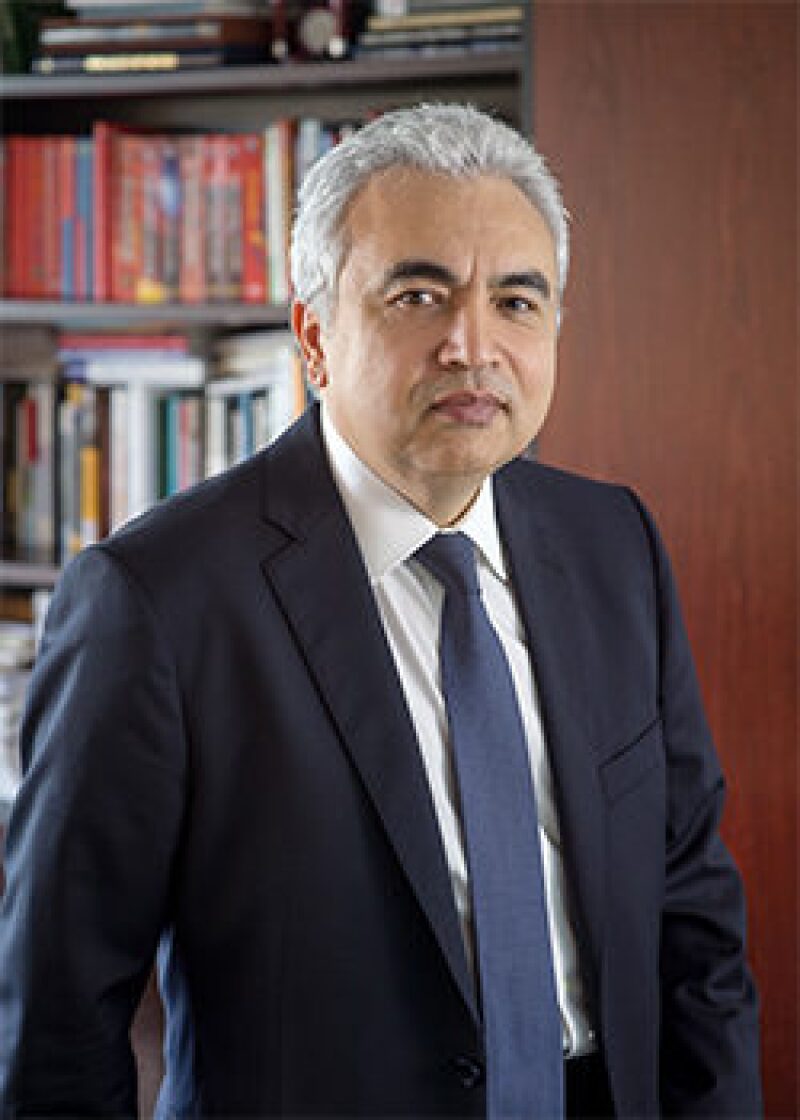Interview conducted by TWA Editors Carter Clemens, Nii Ahele, Bruno Rivas, and Alex Osorio.
Fatih Birol became the Executive Director of the International Energy Agency (IEA) on 1 September 2015. Birol has been named by Forbes magazine among the most powerful people in terms of influence on the world’s energy scene. He is the chairman of the World Economic Forum’s (Davos) Energy Advisory Board and serves as a member of the United Nation Secretary-General’s Advisory Board on Sustainable Energy for All. He is also the recipient of numerous awards from government, industry, and academia. He previously was the IEA chief economist and director of Global Energy Economics, with responsibilities that included directing the Agency’s flagship World Energy Outlook publication, which is recognized as the most authoritative source of strategic analysis of global energy markets. Birol is also the founder and chair of the IEA Energy Business Council, which provides a forum to enhance co-operation between the energy industry and energy policy makers.

I had the privilege of providing an opening keynote address to the G7 energy ministers at their meeting in early April. We discussed a range of topics, including the growing role of shale oil, the importance of LNG [liquefied natural gas] in improving market flexibility and energy security, and the role of energy efficiency and technology as drivers of economic competitiveness. We also discussed the need for better grids, more flexible power plants, and storage and demand side response—all needed to integrate larger shares of wind and solar into power grids in a secure and cost-effective way. G7 countries will have to play a leading role in facilitating investments in these and other areas in order to ensure a secure and sustainable energy future.
Many companies in our industry support the recent signature of the Paris Agreement on climate change. How do you feel about this important milestone? Do you believe the world is in the right place to meet those goals?
It is critically important that industry supports the Paris Agreement. While it is governments and policymakers who will set the goalposts and implement policy to encourage the necessary energy sector transformation, ultimately it is the private sector that will be responsible for much of the investment and innovation needed to get on track.
But we are not yet on track. In our recently released report Tracking Clean Energy Progress 2017, we noted that out of 26 technologies and sectors, only energy storage, wind and solar (photovoltaic), and electric vehicles are on track for a 2-degree target. The vast majority of other technologies, ranging from trucks and aviation, to cement and chemicals, have shown some improvement but will require significant effort to get on track. Other important technologies such as carbon capture and storage, and biofuels, are definitely not on track if we are to meet our climate goals.
So, we should not underestimate the task ahead. Limiting carbon emissions and changing our energy systems is a monumental challenge. But the IEA is working with governments and businesses around the world to help identify solutions and show how it can be done.
Carbon pricing seems to have played a large role in aiding the transition from coal to natural gas in the United Kingdom from 2015 to 2016. Do you foresee similar shifts possible in the future for other countries?
Transitioning away from coal to low-carbon power generation will be central to the global energy transition. Though it appears coal will continue to play a role, at least in the medium-term, policies can play a significant role in encouraging this transition.
In the World Energy Outlook 2016 (WEO) central scenario, we assume carbon prices are progressively applied in more regions of the world and at higher levels through 2040. Such carbon pricing can certainly play a role in encouraging a shift from coal-fired power to natural gas.
That said, putting an effective price on carbon will take time, and the energy transition is urgent. Other policies and market frameworks that encourage a transition to low-carbon power and take into account its inherent value are likely to play a more immediate and impactful role with the energy transition in the short to medium term. In addition to putting a higher price on carbon, such policies can also raise the competitiveness of biofuels, make carbon capture and storage more attractive, and drive a further transition to renewable power.
How do you see renewable energies impacting the supply/demand equation in the upcoming 15–20 years?
Any credible path to achieving the world’s climate objectives must have renewable energy at its core. Recent developments have been very encouraging. For example, wind turbines and solar cells (PV) have been the two fastest growing sources of electricity worldwide since 2010 thanks to support policies and massive technology cost reductions. However, the next chapter in the rise of renewables requires more work on system integration. This means better grids, more flexible power plants, and storage and demand side response so larger shares of wind and solar can be integrated in a secure and cost-effective way. More work also needs to be done to expand the use of renewables beyond the power sector.
| Advice to Young Professionals |
|---|
Forbes named you one of the most influential people in the energy scene around the world. What career decisions or moves helped you get to this point? I began my academic career as an engineer. Initially I was interested in machines, engines, and the physical processes that form the basis of the energy sector. Yet I made a decision to go abroad and study economics because of the human dimension—I thought economics is closer to people’s daily lives. The relationships between individuals, businesses, and countries are what make the global energy sector so exciting, dynamic, and challenging. I applied this combination of skills to my first job working as an oil analyst at OPEC—it was a comfortable, permanent job that I could have enjoyed for many years. However, I made the decision to leave and join the IEA to see the other side of the energy story. This was a critical decision in my career. Ultimately, my career trajectory has mirrored the ever-growing importance of the energy sector to the world economy and international affairs. These education and career choices drew me ever closer to the centre of global discussions on energy, and expanded the focus of my work to include the entirety of the energy mix. This allowed me in turn to work closer with the governments, businesses—and most importantly people—who have been vital to the evolution of the energy sector itself. Working with multicultural and global teams is one of the benefits of our industry. Do you have any advice for how you have been so successful dealing with team members and bosses from around the globe? Diversity is the key word for me; it is a great strength. I am reminded of this every day when I come to work at the IEA. Just as a strong and secure energy system requires a diverse mix of fuels, so does a strong and secure organization or business require a diverse workforce. When we all learn from each other, and our broad range of experiences and perspectives, we put ourselves in a better position to make informed decisions. Each and every day I have the fortune of working with IEA staff from not only a wide range of countries from around the world, but also a range of industries. They all bring their own unique and valuable perspectives, insights and experiences to the job and the IEA as an organization. Earlier we mentioned your influence around the world energy scene; do you have any tips for our readers on how to effectively influence others on viewpoints you find important? The key to influencing a discussion doesn’t start with trying to convince others that you are right. Rather, it starts with listening to what everyone else has to say. Unfortunately—and this is particularly true in the energy and climate discussion—too often we see increasingly polarized discussions. For example, when it comes to coal, representatives of industry, environmental groups, and governments of developing countries seeking to provide power for their people struggle to find a middle ground or even a common language. When we approach issues in such a polarized way, there is very little opportunity for making meaningful progress. This is why at the IEA we have placed such emphasis on dialogue. Our industry groups, including Energy Business Council, and the advisory boards on oil, coal, renewables, and energy efficiency are central to the role we play in examining the entirety of the energy mix. Have you read any books recently that you would recommend for young professionals in the energy industry? Forgive me if I recommend a series of IEA books! First of all, I think for anyone in the energy sector the WEO, our flagship publication, is required reading. I am clearly biased, but I firmly believe that the WEO is the foremost reference for energy professionals. It is virtually impossible to sum up the global energy system in any single book —but I think WEO does a better job than most. This year’s WEO, to be released in November, will provide an outlook of China’s energy system and also feature a special focus on natural gas. Reading it in tandem with our annual Market Reports, World Energy Investment, and Energy Technology Perspectives—to name just a few—will provide a very solid basis to any young energy professional. We will also be publishing a report this year on the intersection between energy and digitalization. In this first edition we will explore how digital industries and technologies are changing the energy sector, as well as the implications of a changing energy sector on the digital realm. This is a topic that we will be mainstreaming into all of our work and publications in the future. Finally, the most important thing any young professional can do is pick up a newspaper, every morning. Energy is not just about energy, and to truly understand where the sector is headed, you need to understand what is happening in politics, business, economic development, science, and much more. Only by being informed about what is happening in the wider world can any of us predict what the energy sector could look like 10, 20 or 50 years from today. |

